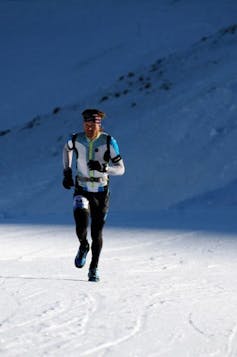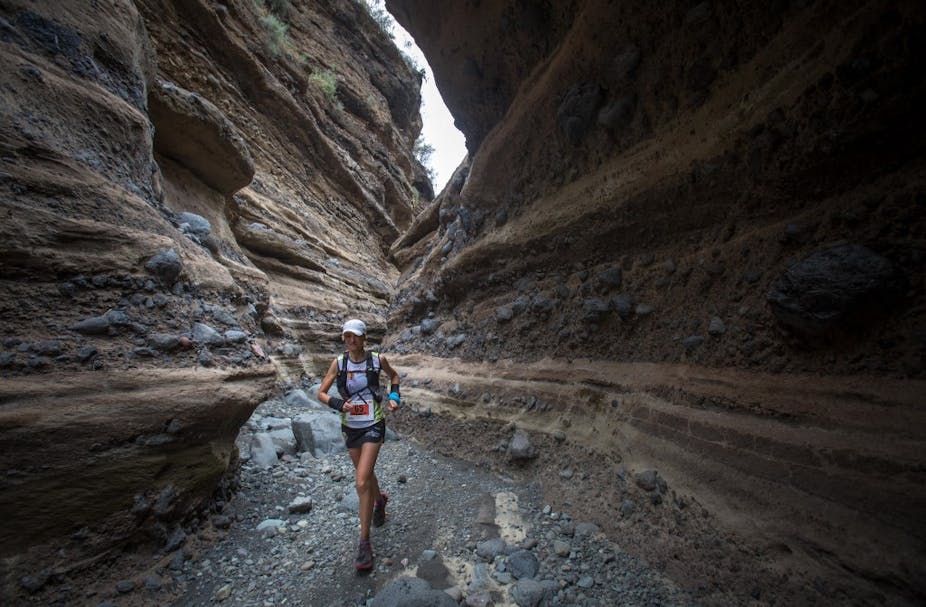With an estimated 20 million participants since 2010, trail running has been one of the world’s fastest growing sports, according to the International Track and Field Federation. However, the combination of the Covid-19 pandemic and the ongoing climate crisis have put the development of this discipline in jeopardy. Despite the challenges, runners and stakeholders are working hard to ensure that runners are able to hit the trails.
An immersive experience in nature
Trail running is an outdoor sport that provides an immersive experience deep in the heart of natural landscapes – in the mountains, near the ocean coasts, in the wilds of the desert, or in the depths of the forests.
Officially, trail running is defined as a pedestrian competition open to everyone, taking place in a natural environment, and whose total distance cannot be on more than 20% on cement or asphalt roads. This definition was created in 2013 by the International Trail-Running Association (ITRA), an organization set up by the main players to organize the discipline and promote its development worldwide.
Trail running existed well before the creation of ITRA, of course. Its roots stretch back to the 1970s in the American West and in the ‘80s and '90s in Europe.
The sport took off at the beginning of the new millennium, experiencing significant growth in the number of events and participants. From 2013 to 2019, ITRA recorded more than 25,700 races in 195 countries with nearly 2 million competitors, a testament to its enormous success.
Sudden health crisis
When the Covid-19 global pandemic broke out in early 2020, the entire sports sector has faced an unprecedented crisis. The measures imposed to contain the spread of infections affected nearly half of the world’s population at the end of March 2020.
These measures resulted in numerous cancellations of outdoor running events and series around the world. In 2020, the Ultra-trail World Tour did not award a title and both the Golden Trail World Series and Skyrunning World Series were cancelled.
Though all the repercussions of this crisis are not yet known, the impacts will certainly be considerable – they could even cause the permanent closure of some events. More broadly, those who work in the regions where the events take place suffer from these cancellations. Outdoor sports events are crucial for the local economy by generating tourist dollars and interest. The economic spin-offs generated by some of these events can be quantified in millions of dollars – for example, nearly $8.5 million for the 2017 UTMB.
For elite and amateur athletes alike, keeping moving is a way to cope with this period of uncertainty where travel has been severely restricted. Restricted to their homes, creative athletes ran a marathon on a balcony, climbed the equivalent of the Ultra-Trail du Mont-Blanc, and ran the distance of a 160km ultra-trail at home or around a tree.
Companies such as Asics and Strava as well as event organizers have created digital solutions that offer virtual challenges or races. These “phygital” events allow runners to participate from home or close to home (GPS tracking devices proved that the challenge was completed). This new type of sporting event increased in popularity during the Covid-19 crisis and has successfully spread around the world. This has allowed the primary stakeholders of the trail-running industry to provide support to their community of runners and compensate for the current impossibility of in-person races.
Another striking phenomenon for trail running is the renewed interest in the practice of so-called “Off” or “FKT” (fastest-known time) challenges originating from lockdown.
Such challenges outside of traditional competitions aren’t new; they represent record-setting attempts on long-distance hiking (LDH) trails or the creation of new running routes in the great outdoors. Many records were set during the summer of 2020, such as Xavier Thévenard success on the GR 20 in Corsica’s (180km), and Mathieu Blanchard’s crossing of the International Appalachian Trail in Quebec (650km). With international travel out of the question, alternative ultra-local projects are an opportunity to (re)discover and explore areas close to one’s own region or country of residence.
Ecological crisis obligations
The second crisis facing the trail-running industry is climate change. Races frequently take place in remote and protected natural areas, and when hundreds, even thousands of runners pass through, it has an impact on vegetation, wildlife and soil. The environmental footprint of a trail-running event should not be underestimated – transportation, soil and plant damage, waste management, and more.

Whether large or small, such events force organizers to examine the necessary changes imposed by the ecological crisis and the evolution of trail-running practices. Organizers must be attentive to the environmental issues and share the values promoted by the sport and ITRA of respect for the environment and sustainable development. Ethics and eco-responsibility are thus at the heart of many events.
Organizers are seeking to limit the impact of their events on the environment – restricting the number of participants, raising awareness and eco-responsible actions, reducing waste and taking action to protect the environment. Athletes are also examining their own carbon footprint and working to reduce it: raising awareness, creating foundations, working with equipment manufacturers and more.
Post-Covid-19 challenges
The intersection of the ecological and health crises is a moment of truth for the trail-running community. Athletes and other stakeholders have shown creativity and are adjusting to meet these unprecedented challenges. At the heart of the trail-running experience, two elements remain fundamental: a deep immersion in nature, and building social relationships. These sporting events are necessarily spaces for multifaceted interactions with the environment and other participants.

As appealing they may be, it’s unlikely that virtual races and other “off” challenges will become more popular than genuine trail running itself. Still, time will tell whether these alternatives will remain temporary or will become more firmly rooted in the discipline’s practices.
While the Covid-19 pandemic may one day ebb, the climate crisis is with us to stay. The trail-running stakeholders’ environmentally responsible policies show a clear awareness of current issues. The goal must be to guarantee the benefits of trail running for runners and visitors alike, without overlooking or excusing the environmental impact of the practice. The biggest challenge for the trail-running community is thus to ensure the long-lasting and sustainable development of this popular outdoor sport.


